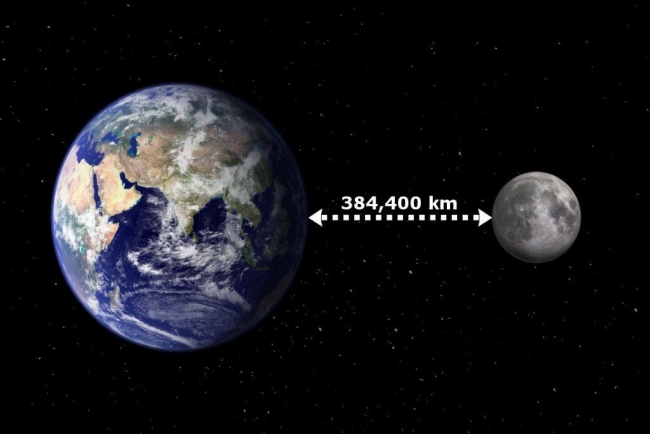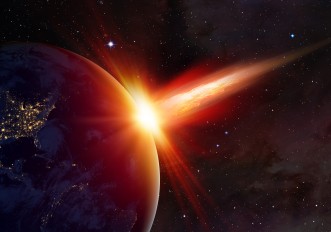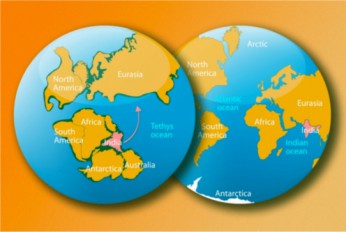Moon is making the days on Earth longer

A study shows evidence that as the distance between Earth and the moon increases year by year, the days are getting longer.
Researchers at the University of Wisconsin-Madison claim that moon continues to move away from Earth at 3.82 cm. a year. They have found that 1.4 billion years ago the moon orbited much closer to the planet, altering the way it spins on its axis. As a result, a day was once only 18 hours.
It is obvious that somehow the distance between the Earth and moon is related to the angular velocity of the Earth around its axis. Stephen Meyers, professor of geoscience at the University of Wisconsin-Madison and author of the study, said: "As the moon moves away, the Earth is like a spinning figure skater who slows down as they stretch their arms out." However the augmenation of the daytime is not notable in the manner that people perceive time. A few years ago, astronomer Britt Scharringhausen estimated that in 100 years, the day will be two milliseconds longer. Therefore, we or the next generations will not be affected by this phenomenon.
The scientists at UW reached their findings, which were published in the journal Proceedings of the National Academy of Sciences, by drawing on astronomy and geology. Using a statistical method called astrochronology, they examined billion-year-old rock sediment and reconstruct a history of the solar system through geological indicators. Professor Meyers states: "One of our ambitions was to use astrochronology to tell time in the most distant past, to develop very ancient geological time scales. We want to be able to study rocks that are billions of years old in a way that is comparable to how we study modern geologic processes."
Scientists must now investigate whether the moon's rate of movement has always been constant in its 4,5 billion years history. For now, the moon continues to move away from Earth each year. According to Meyers' team's research, days will continue to get longer as time goes on, whether or not these changes will be perceptible in the near future.
Sources: Independent.co.uk, Dailymail.co.uk
Want to read more like this story?

Earth and Moon struck by asteroid shower 800 million years ago
Jul, 21, 2020 | NewsAccording to a new study, a vast meteoroid bombardment struck the Earth and the Moon about 800 mill...

USGS releases the first meticulous geological map of the Moon
Apr, 20, 2020 | NewsThe United States Geologic Survey (USGS), in collaboration with NASA and the Lunar Planetary Instit...

Increased seismic hazard due to Earth's rotation slowdown
Jun, 28, 2018 | NewsScientists from the U.S. believe that a significant increase of earthquakes will occur beginning fro...

The Birth of The Himalayas
May, 27, 2015 | NewsFive weeks after the terrible earthquake in Nepal which literally shook the Himalayas, researchers f...

India to become the 4th country to land on the moon
Sep, 06, 2019 | NewsThree countries, U.S., Soviet Union and China, have managed to land a spacecraft on the moon's surf...

The oldest substance on Earth found in a meteorite
Jan, 13, 2020 | NewsThe oldest material on Earth was discovered in a meteorite that fell 50 years ago in Australia. The...

New findings about Martian landslides
Oct, 25, 2019 | NewsA new study, published in Nature Communications, reveals new evidence about Martian landslides. Th...

''Snowball Earth'' triggered by the advent of plate tectonics?
Jun, 05, 2018 | NewsDuring the Neoproterozoic, a geological era which occurred about 542 million to one billion years ag...

Research: Seasonal Variations Of Seismicity
Sep, 25, 2015 | NewsFor a reason that scientists have yet to discover the most powerful and with the largest focal depth...
On This Day
April 17th 2012
READ MORE
Trending

Massive earthquake struck Philippines

Using Terzaghi’s Equation in Foundation Design

Is Africa gradually splitting into two sections?

Eden Project in the UK closes due to landslides and floods

Hollywood Hills: A landslide occurred again, destroying a newly constructed home

RocSlope3 and RocFall3’s Integrations for Rock Slope Analysis


